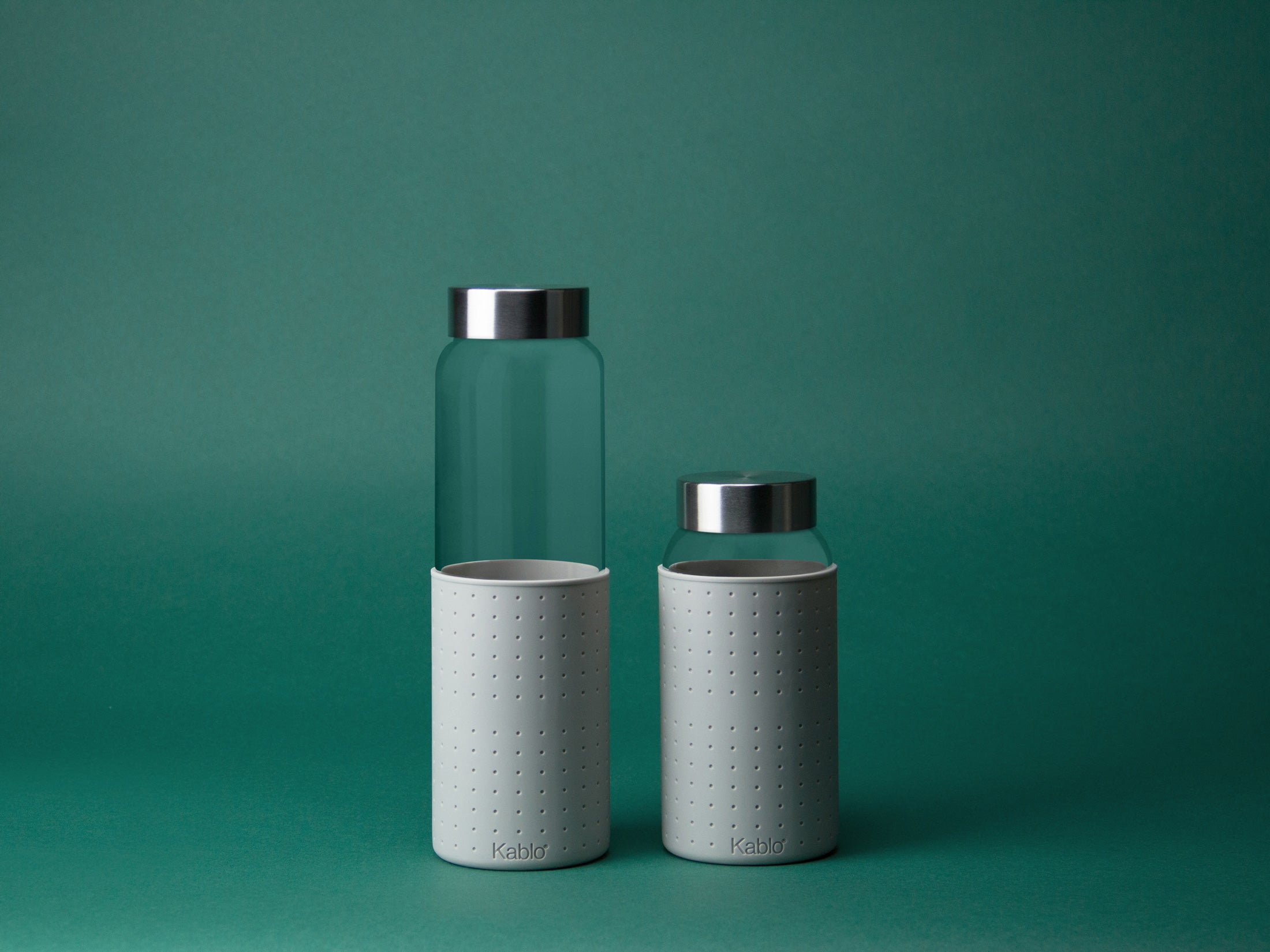What Is Borosilicate Glass And Why Is It Better Than Regular Glass?

What is borosilicate glass?
Borosilicate glass is a type of glass that contains boron trioxide which allows for a very low coefficient of thermal expansion. This means it will not crack under extreme temperature changes like regular glass. Its durability has made it the glass of choice for high-end restaurants, laboratories and wineries.
What most people don't realize is that not all glass is created equally. Take our high-grade borosilicate Kablo bottles for example.
Borosilicate glass is made up of about 15% boron trioxide, which is that magical ingredient that completely changes the behavior of glass and makes it thermal shock resistant. This allows the glass to resist extreme changes in temperature and is measured by the “Coefficient of Thermal Expansion,” the rate at which the glass expands when it is exposed to heat. Thanks to this, borosilicate glass has the ability to go straight from a freezer to an oven rack without cracking. For you, this means you can pour boiling hot water into borosilicate glass if you wanted to say, steep tea or coffee, without worrying about shattering or cracking the glass.
What’s the difference between borosilicate glass and soda-lime glass?
Many companies choose to use soda-lime glass for their glass products because it is less expensive and readily available. It accounts for 90% of manufactured glass worldwide and is used for items like furniture, vases, beverage glasses and windows. Soda lime glass is susceptible to shock and does not handle extreme changes in heat. It’s chemical composition is 69% silica (silicone dioxide), 15% soda (sodium oxide) and 9% lime (calcium oxide). This is where the name soda-lime glass comes from. It is relatively durable at only normal temperatures.

Borosilicate glass is superior
The coefficient of soda-lime glass is more than double that of borosilicate glass, meaning it expands more than twice as fast when exposed to heat and will break very quickly. Borosilicate glass has a much higher proportion of silicon dioxide in comparison to regular soda lime glass (80% vs. 69%), which makes it even less susceptible to fractures.
In terms of temperature, the maximum thermal shock range (the difference in temperatures it can withstand) of borosilicate glass is 170°C, which is about 340° Fahrenheit. This is why you can take borosilicate glass (and some bakeware like Pyrex—more on this below) out from the oven and run cold water over it without shattering the glass.
*Fun fact, borosilicate glass is so resistant to chemicals, that it is even used to store nuclear waste. The boron in the glass makes it less soluble, preventing any unwanted materials from leaching into the glass, or the other way around. In terms of overall performance, borosilicate glass is far superior to regular glass.
Is Pyrex the same as borosilicate glass?
If you have a kitchen, you’ve probably heard of the brand name ‘Pyrex’ at least once. However, borosilicate glass is not the same as Pyrex. When Pyrex first hit the market in 1915, it was initially made from borosilicate glass. Invented in the late 1800s by German glassmaker Otto Schott, he introduced the world to borosilicate glass in 1893 under the brand name Duran. In 1915, Corning Glass Works brought it to the U.S. market under the name Pyrex. Since then, borosilicate glass and Pyrex have been used interchangeably in the English-speaking language. Because Pyrex glass bakeware was initially made of borosilicate glass, it was able to withstand extreme temperatures making it the perfect kitchen staple and oven companion, contributing to its huge popularity over the years.
Today, not all Pyrex is made of borosilicate glass. Some years ago, Corning switched the material in their products from borosilicate glass to soda-lime glass, because it was more cost-effective. So we can’t really be sure what is actually borosilicate and what is not in Pyrex's bakeware product line.

What is borosilicate glass used for?
Because of its durability and resistance to chemical changes, borosilicate glass has traditionally been used in chemistry labs and industrial settings, as well as for kitchenware and premium wine glasses. Because of its superior quality, it is often priced higher than soda-lime glass.
Should I switch to a borosilicate glass bottle? Is it worth my money?
Great improvements can be made with small changes to our everyday habits. In this era, buying disposable plastic water bottles is just plain silly considering all the alternative options available. If you are thinking about buying a reusable water bottle, that's a great first step in making a positive lifestyle change. It's easy to settle for an average product that is inexpensive and does the job, but that's the wrong mindset if you are looking to improve your personal health and make positive lifestyle changes. Our philosophy is quality over quantity, and purchasing long-lasting products is money well-spent. Here are some of the benefits of investing in a premium reusable borosilicate glass bottle.
It’s better for you. Since borosilicate glass resists chemicals and acid degradation, you don’t need to worry about stuff seeping into your water. It's always safe to drink from. You can put it in the dishwasher, put it in the microwave, use it to store hot liquids or leave it out in the sun. You won’t have to concern yourself with the bottle heating up and releasing harmful toxins into the liquid you are drinking, something very common in plastic water bottles or less expensive stainless steel alternatives.
It’s better for the environment. Plastic water bottles are terrible for the environment. They are made from petroleum, and they almost always end up in either a landfill, lake or ocean. Only 9% of all plastic gets recycled. Even then, often times the process of breaking down and reusing plastics leaves a heavy carbon footprint. Since borosilicate glass is made from naturally abundant materials that are more easily acquired than oil, the environmental impact is also smaller. If handled with care, borosilicate glass will last a lifetime.
It makes things taste better. Have you ever drank from plastic or stainless steel bottles and tasted the plastic or metallic flavor from which you are drinking? This occurs because it is actually seeping into your water due to the solubility of the plastic and steel. This is both harmful to your health and unpleasant. When using borosilicate glass the liquid inside remains pure, and because borosilicate glass has low solubility, it keeps your beverage free from contamination.
Glass is not just glass
While the different variations may look similar, they are not the same. Borosilicate glass is a significant upgrade from traditional glass, and these differences can make a big impact on both your personal health and the environment when compounded over time.
We’ve designed Kablo bottles so that you can maximize the health benefits of drinking water. A wide mouth provides ample room for ice cubes, fruit or herb infusions, and you may use your Kablo bottle to steep your favorite tea or coffee (safely). It saves time and money because you can prepare and enjoy your own beverages in advance, instead of buying pre-bottled health tonics and pressed juices in plastic disposable containers. It takes time to transition to a greener, more conscious lifestyle. But with the right mindset and concentrated effort, we can all get there. An eco-friendly water bottle is just one step we can take towards a smarter, more sustainable lifestyle.
–
p.s. have you joined our newsletter yet? Subscribe for occasional updates with green-living tips, stories from people who inspire us, special promos and more.
You can also follow along on Instagram: @kablo_official

